Building a shooting range is one of the best ways to become a better shooter and train more often. Depending on how often you go shooting, having your own range could save you money from range fees or membership fees in the long run.
To build a shooting range, plan out a safe location keeping in mind what will be behind your targets and where the firing lanes will be. Build berms or backstops in the planned locations and set up targets. Know your shooting locations, have a safety plan, and layout your range rules.
Since I’ve built my shooting range, I go shooting about 10x’s as often. It’s a great way to get the most out of my firearms when I can just walk out back and be shooting in minutes.
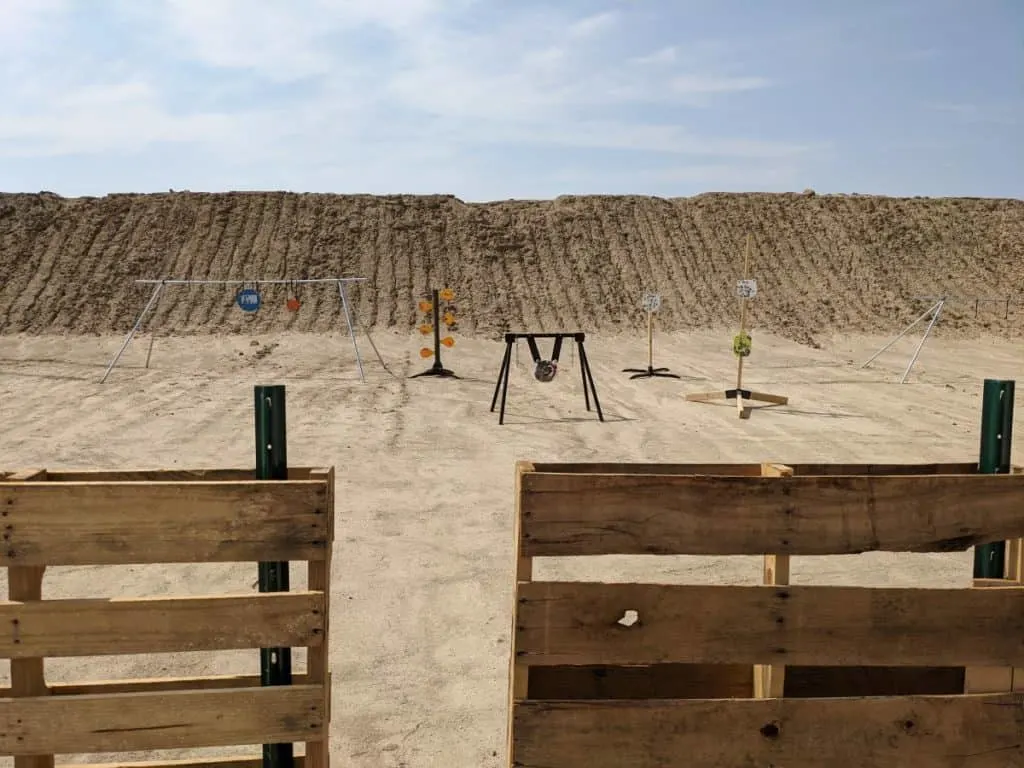
Plan The Layout of Your Shooting Range
Start to plan the layout of a shooting range by walking the area you plan on building. Decide where berms will go and where shooting lines will be. Make sure you’ll be shooting in a safe direction without obstructions and be aware of what’s behind what you’re shooting at.
Planning the layout is probably the most important step. Once you have a good plan, the rest is just executing the plan.
Here’s some quick tips to think about during the planning phase:
- Level ground is preferred
- Sloping down is better than sloping up
- Avoid firing into the sun
- Avoid rocks (ricochets)
- 6ft berms or higher
- What’s behind the targets
I built rifle, pistol, and shotgun areas on my range. That means I needed a couple 100 yard lanes for rifle shooting, a small pistol course, and an area to shoot clays. I planned and marked that all out before moving any dirt.
To make sure I wasn’t going to endanger anyone if a round makes its way over the berm, I looked on google maps to see what was behind. I planned the berms facing a direction that had nothing behind them for miles.
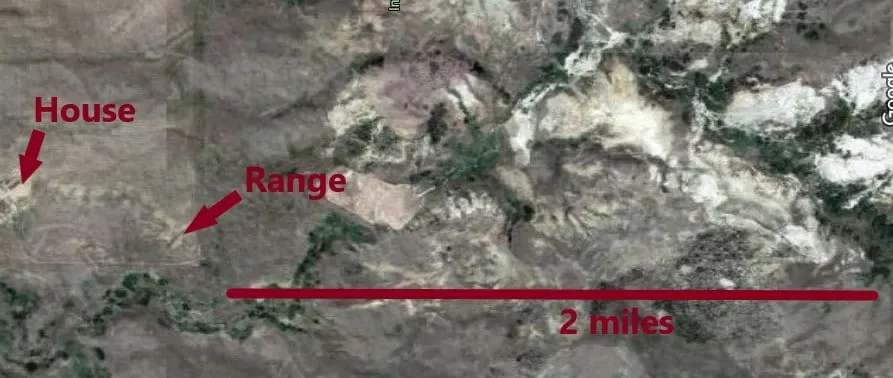
Marking The Range
I used flags and ground marking paint to mark where the shooting bench, shooting lanes, and berms will all be going. I’m glad I did because after looking at the layout, I made some adjustments to my original plan. It’s worth the little effort now to save a lot of headache later on if you decide to change something.
Inverted Marking Paint (link to Amazon) is perfect for marking the layout.
Drainage
Making sure the range could drain was important for me where we are. Since I wasn’t planning on putting down a surface of any kind, it would be all sandy clay dirt. I didn’t want pools of water and mud all over the place, so I had to put a small 1 or 2 percent slope.
It’s best to be shooting on level ground for sure, but a slight slope won’t be all that noticeable and will help keep the range dry and solid.
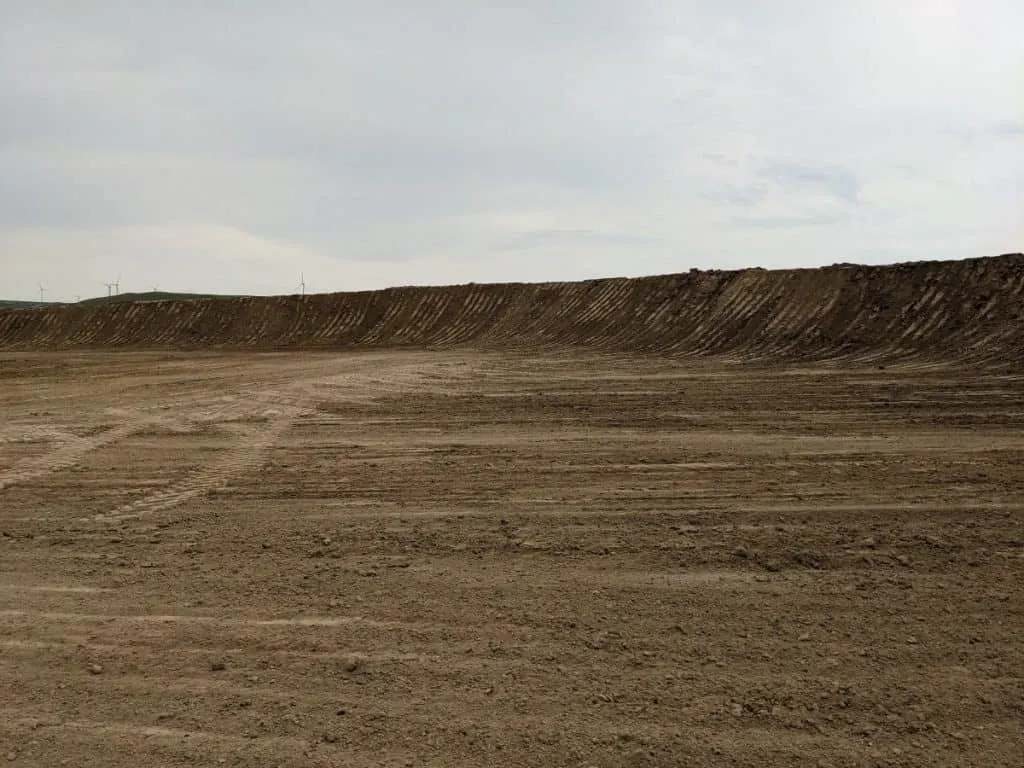
Shooting Range Build Requirements
Shooting range build requirements include side containment, target line distances, surface material, firing line cover, firing point depth, landscaping, impact material, and backstop material. Knowing where you are shooting and what you’re shooting covers most of this.
There’s no reason to go overboard, but it’s good to have an idea of what you’ll be using the range for and make yourself a list of requirements.
My list of requirements:
- 100 yards lane for zeroing rifles
- Pistol shooting course with multiple stations to move between
- Shotgun clay shooting area with a pigeon thrower setup
- 12 ft high berm, 120ft long, with 50 ft long side containment berms
- 2% sloped landscape for drainage
- Nothing behind the shooting berm for 1.5 miles at least
- Rocks and boulders moved out of the area
Here’s a link to the US Department of Energy Range Design Criteria. There’s some useful info in there but it’s mostly for official ranges being built for public use. Most of it doesn’t really apply to building a private range on your own property, but can help give ideas.
Building The Shooting Range
Once the layout was complete, It was time to actually build the range. We used a 624L loader to make a flat (2% sloped) area and used that dirt to make the berms. After the planning phase the whole job only took a few days.
This type of range setup with dirt berms could also be done with excavators or a big bulldozer. I’ve seen something similar done with just a skid steer as well. If you marked and flagged everything properly, this part is done a lot easier with machinery.
Here’s a video showing the whole process of my range being built:
How To Build A Shooting Range Backstop
The most common ways to build a shooting range backstop are to use berms, railroad ties, tires filled with sand or dirt, Hesco barriers filled with sand or dirt, sandbags, or a combination those options. The shooting range backstop should be at least 6ft tall and 10ft wide per shooting lane.
With my range I choose one of the safest and most cost efficient methods, big piles of dirt. I have large 12ft berms in a semi-circle shape which allows for maximum shooting lanes in the space I had. Berms are great for small or larger ranges and are easy to maintain.
Shooting Range Backstop Height
The average shooting range backstop height is between 6-12 feet. A 4ft backstop height will work for prone or shooting from a knee. 6-8 foot minimum backstop height is recommended for standing or bench seated shooting on level ground. Most public shooting ranges have a minimum 10ft backstop height.
I put 12ft berms on my range since I will be shooting from a standing position, from a bench, or while moving a lot of the time. It’s really up to you and what your needs are, but It’s always safer to go bigger than what you think you’ll need.
Shooting Range Backstop Materials
The most popular shooting range backstop materials are dirt, sand, wood, or rubber. Indoor shooting ranges use granular rubber or rubber block traps, while outdoor ranges mostly use tall berms of dirt. Filling tires with sand or using railroad ties are popular in backyard shooting ranges.
I personally prefer to just pile up a bunch of dirt into a berm and use that. If you don’t have a bunch of extra dirt you can use, railroad ties are the next best option.
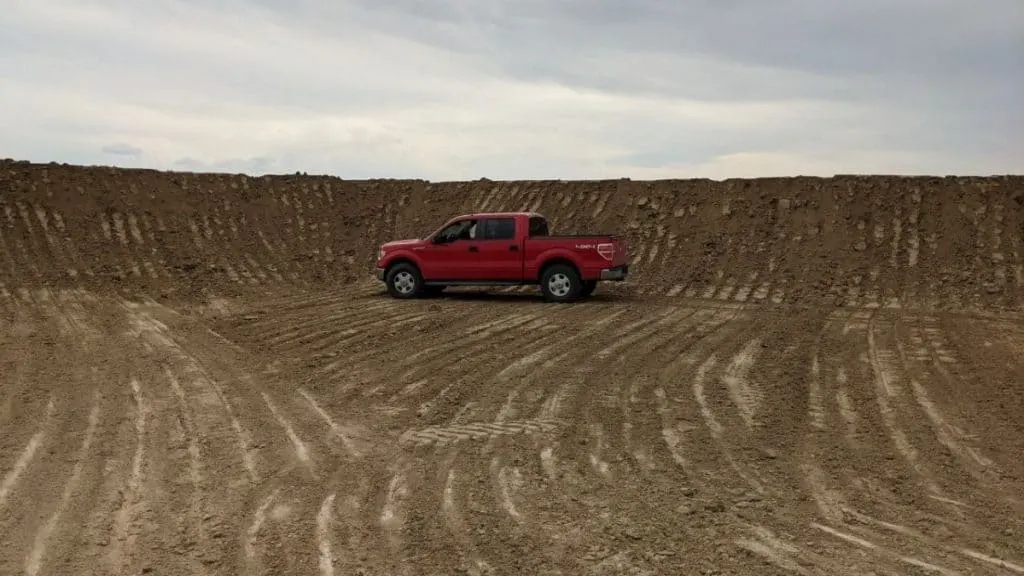
Railroad Ties Shooting Range Backstop
To build a shooting range backstop with railroad ties, you need to stack the railroad ties 6-8 feet high (or to your desired height) and secure them in place with a wooden frame or t-posts. Stack the railroad ties two deep and offset the seams of the two layers.
The bullets mostly lodge into the railroad ties and they last for years. Railroad ties are easy to stack to your preferred height and can be held in place with T-Posts or wooden posts concreted into the ground.
A railroad tie backstop looks nice too. Most people want two layers (offset from each other) to prevent bullets from going in between the ties or they’ll use one layer with a berm of dirt on front of or behind the backstop.
Here’s an article from msstate showing how to make a simple railroad tie backstop if you want to go that route. I recommend combining with dirt berms if you can, but anything that gets you shooting is a good thing.
Build A Shooting Range Backstop With Tires
To build a shooting range backstop with tires, stack the tires to your backstop height and fill with dirt. Place the tires to overlap each other with each layer to prevent them from falling over. Fill the tires with sand or dirt as you add new layers until the desired backstop height is reached.
A lot of people use tires or Hesco barriers filled with sand or dirt. We used Hesco barriers a lot in Iraq for shelter because they can stop bullets, but they can also stop shrapnel from incoming mortars. The tires won’t be as thick, but work in a similar way, something containing a bunch of dirt to stop bullets.
Using tires is very similar to using berms, except the dirt is contained and you won’t need as much of it. A tire backstop should last years, but are a huge pain to maintain whenever you do need to change out some tires.
Targets For A Shooting Range
Shooting steel is one of the most fun and one of my favorite ways to use the range. But you do still want paper targets to zero in rifles or work on your groupings.
I have an entire page all about Shooting Steel Targets that will cover everything you need to know about that. So in this article, I’ll just quickly cover some recommendations for target shooting.
Paper Targets
Paper targets are almost a necessity to have on any range. They’re quick and easy to use, just staple them onto a stand and start shooting. Paper targets are the best way to keep track of precision and how your firearms are grouping shots.
Here are the two paper targets I use the most, they’re cheap, have great ratings, and do the job I need them for:
Steel Targets
You can have a fun day shooting without steel, no problem. But once you start shooting steel, it’s like shooting for the first time all over again. You will be filled with joy and happiness found nowhere else in this world.
Definitely check out that Steel Targets Page I made if you really want to get into that. Real quick though, here are some steel targets I’ve enjoyed the most:
- For Pistol: Pistol Dueling Tree
- For Rifle: 1/2″ AR550 Silhouette and Gong
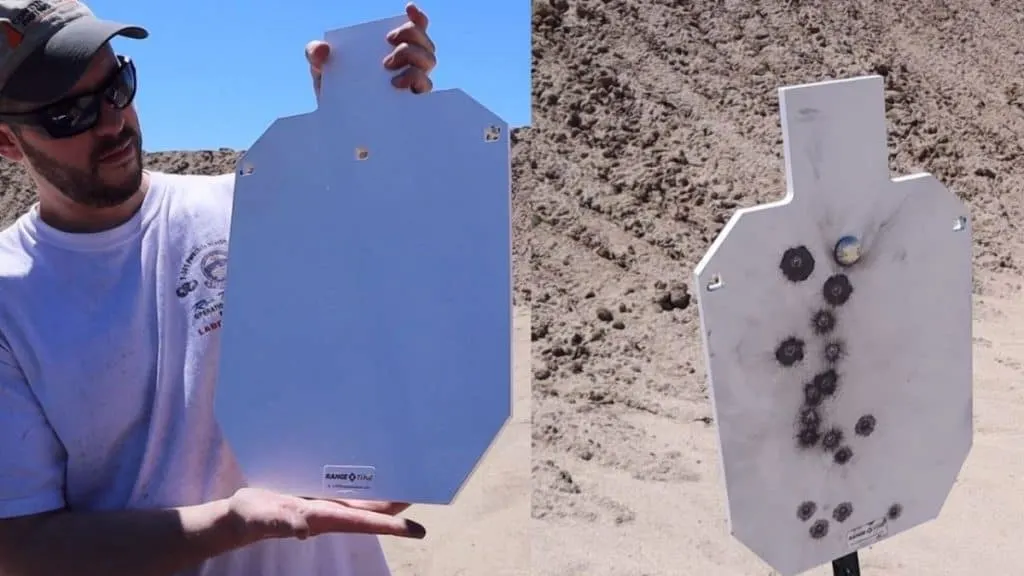
Target Stands
You’ll need something to hang or mount your targets on that is safe to shoot at. Most of the time that involves some sort of frame or stand.
Paper Target Stands:
For paper targets, I just gather some pallets from business’s in my area and staple the paper targets to that. It works a charm and doesn’t cost anything, that’s hard to beat. I just hammer a wooden stake into the ground and it holds the pallet upright, perfect for paper targets.
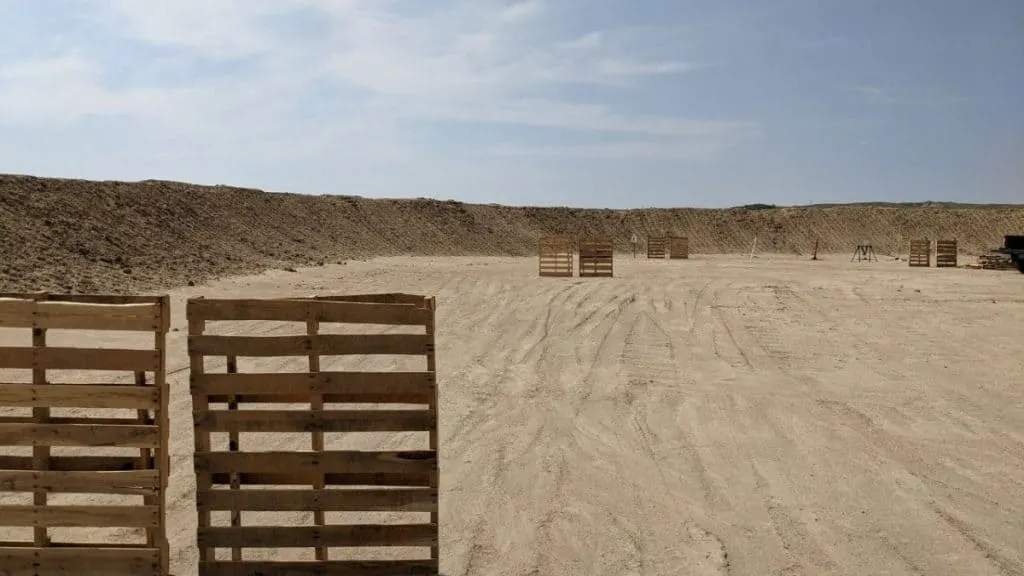
If you can’t get pallets easily, or just don’t like that look. You can get Paper Target Stands Here and they aren’t too expensive.
Steel Target Stands:
There’s a few ways I like to hang and mount steel targets, and you already know what I’m gonna say; check out the Steel Targets Page for more. Here’s the two steel target stand set ups I like the best:
- To Hang Steel: Steel Target Hangers Kit
- To Mount Steel: 2×4 Steel Mount Kit
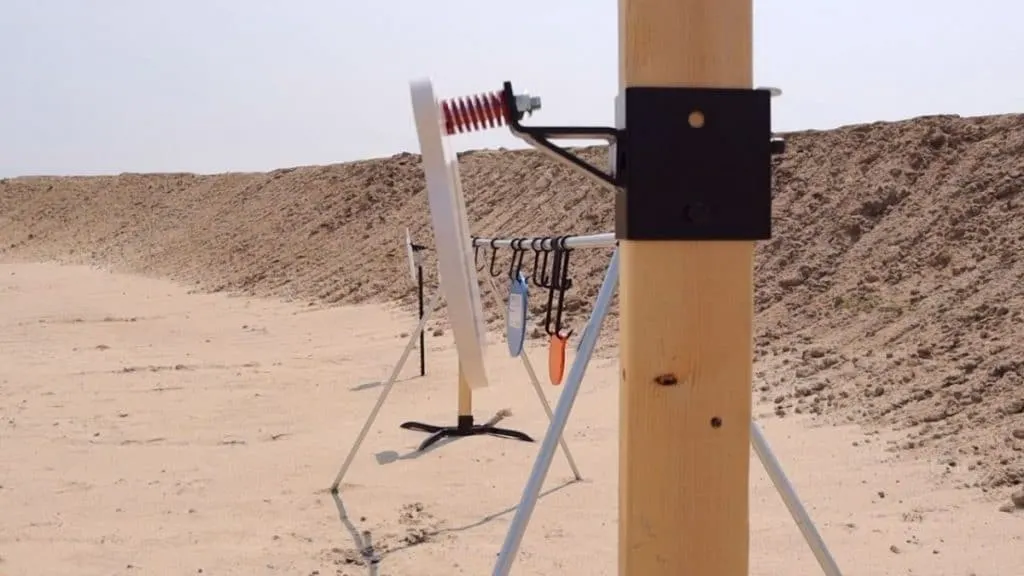
How To Build A Shooting Bench
You’re gonna want somewhere to sit while you zero in rifles or even just a place to set down your ammo and gear. They do make Portable Shooting Bench’s (link to Amazon) that work well, but not really a permanent solution when building your own range.
There are a lot of free plans to build your own shooting bench online. This option will take time and money to buy the lumber and actually build the bench. Instead I built mine out of wooden spools I found for free online.
You could always just use any outdoor table and chair. I’ve purchased legit range quality aluminum shooting bench’s before, and they are really nice. But honestly, if you don’t have the money you’ll be fine with any table or do-it-yourself option.
Wooden Spool Shooting Bench
You can find really cheap wooden spools on craigslist, offer up, or even facebook marketplace. You could also call a local electrical supply company and see if they have any they’re getting rid of.
I like this option because it’s free and simple. Just cut a notch in the spool for a place to sit. Use the notch you cut out as the seat. Now you can sit in the spool and have support for your firearm as well as for your shooting arm.
Shooting Bench Plans
If you can’t find free spools, or just don’t like how they look, you can find tons of free plans online to build your own using lumber and tools.
Here are some links to popular shooting bench plans:
How Much Does It Cost To Build A Shooting Range?
The cost to build an outdoor shooting range is $100-$3000 depending on how much work needs to be done to the landscape. If there are natural berms, a shooting range can be built for less than $200, but if machinery is required to build a safe backstop, it will cost at least $2000.
If you have natural backstops on your property, you may not have to spend anything on your shooting range. Just target costs and a shooting bench if you want one. The real costs come when you need to use equipment to build a range.
I spent around $2800 building 120ft long 12ft high berms for a backstop, and 12ft high 50ft long berms on either side for containment. I’ve also gotten a bunch of steel targets which aren’t cheap. The biggest expense by far was renting the machines to do the job.
If you’re building a railroad tie backstop, it could set you back a bit. I’ve seen railroad ties on some online marketplaces going for free sometimes but the quality isn’t great. Plan on spending about 20 bucks a piece for used railroad ties, or more for good quality.
Paper target stands and shooting bench’s I’ve made for virtually free as I already talked about above. For me it was totally worth the costs, I use the range all the time and the convenience of having your own private range is invaluable.
